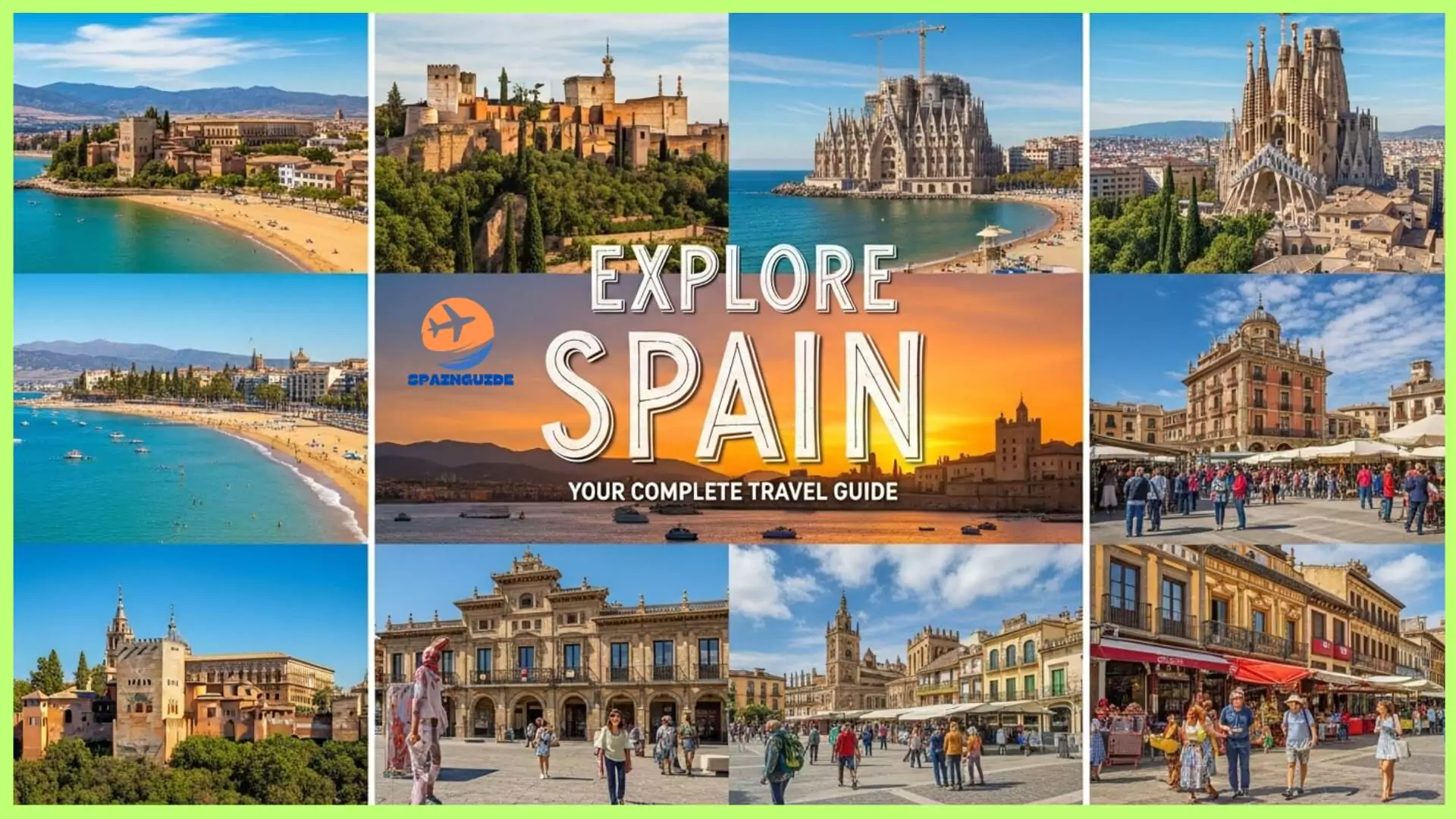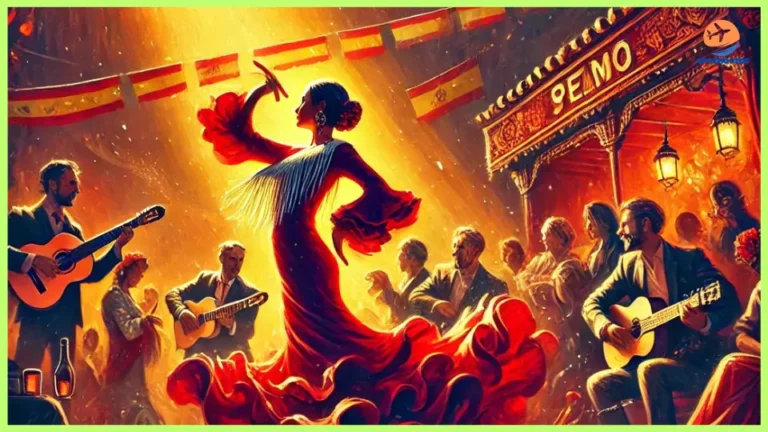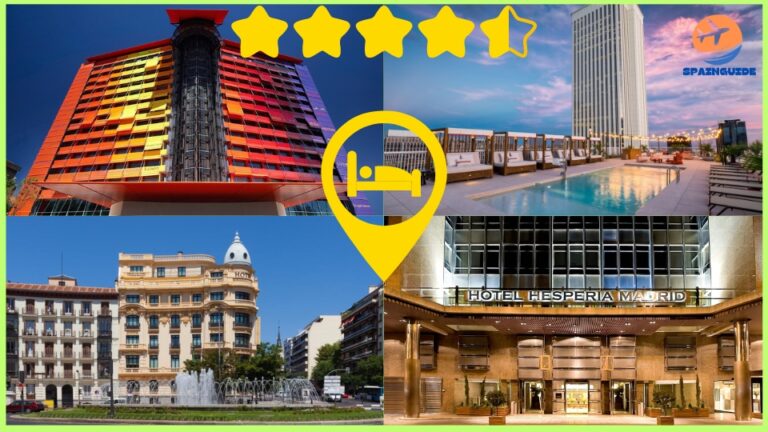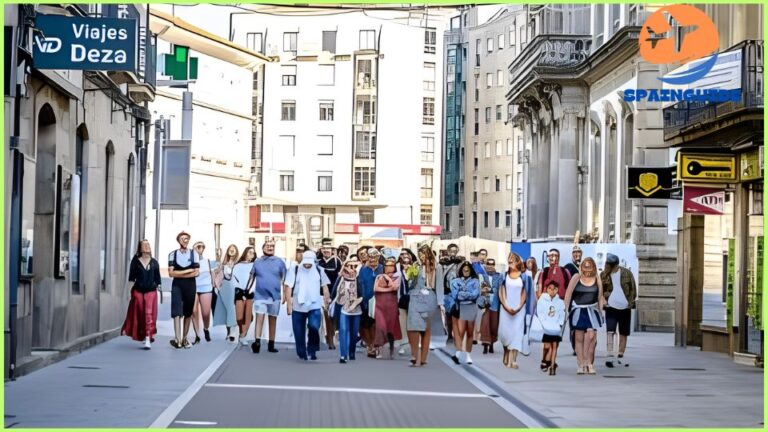Spain Travel Guide – Your Friend’s Honest Take
Let me tell you why Spain is absolutely amazing and why you need to book that flight ASAP. This place has literally everything – I’m talking incredible food that’ll ruin you for life, architecture that’ll make your Instagram followers weep with envy, beaches where you can actually relax, and enough history to make your brain hurt (in the best way).
Whether you’re the type who nerds out over art museums, lives for foodie adventures, gets excited about old castles, or just wants to lie on a beach with a sangria – Spain’s got you covered. I’ve been there multiple times and I’m still discovering new stuff every visit.
From Gaudí’s wild buildings in Barcelona (seriously, this guy was on another level) to Granada’s mind-blowing Alhambra, from flamenco shows that’ll give you chills to food scenes that’ll make you question everything you thought you knew about Spanish cuisine – this country is just non-stop awesome.
I’m gonna walk you through everything you need to know: where to go, what to do, what to eat (this is the important part), when to visit, how to get around without losing your mind, and how to not look like a total tourist. Let’s dive in!
The Must-Hit Destinations (Trust Me On These)
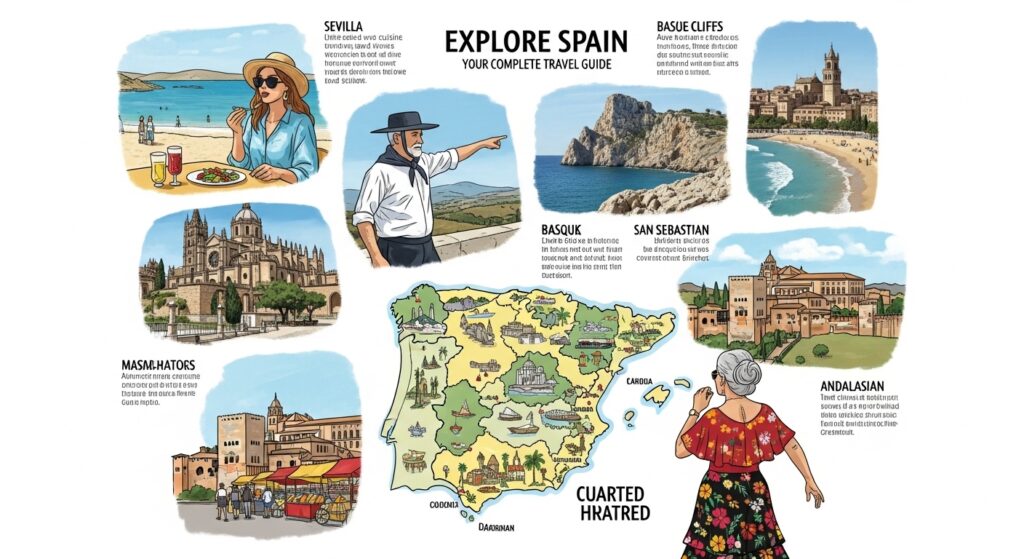
1. Barcelona – The Cool Kid of Spanish Cities
Barcelona is like that effortlessly cool friend who somehow makes everything look amazing. It’s got this perfect mix of old-school charm and cutting-edge vibes that just works.
First things first – you HAVE to see Gaudí’s stuff. The Sagrada Família is absolutely bonkers (in the best way) – it’s been under construction since 1882 and it’s still not done, but honestly, that’s part of the charm. Park Güell looks like it was designed by someone on a really good trip – colorful mosaics everywhere and views that’ll make you forget to check your phone for five minutes.
The Gothic Quarter is where you’ll get deliciously lost among medieval streets, stumble upon hidden squares, and find those perfect little cafés where you can people-watch for hours. La Rambla gets crazy touristy (fair warning), but La Boquería market is worth fighting the crowds for – the jamón there will change your life.
And here’s the kicker – you can hit the beach (Barceloneta) after a morning of museum hopping. The Picasso Museum is fantastic, and if you’re into weird modern art, MACBA won’t disappoint. Plus, the nightlife here doesn’t even start until midnight, so pace yourself!
2. Madrid – Where Royalty Meets Really Good Tapas
Madrid’s got this regal thing going on but without being stuffy about it. The Royal Palace is pretty spectacular – all those fancy rooms will make you wonder what it’s like to have that much gold lying around. The nearby cathedral is gorgeous too, and admission’s free (score!).
But let’s talk about why art lovers literally plan pilgrimages here. The “Golden Triangle” of museums is no joke – Prado has all the Spanish masters (Velázquez, Goya, El Greco), Reina Sofía has Picasso’s “Guernica” which is… intense, and Thyssen-Bornemisza fills in all the gaps. Pro tip: many have free hours, so do your homework and save some euros.
Each neighborhood has its own personality. Salamanca is fancy (and expensive), Malasaña is hipster central, and La Latina is where you go for authentic tapas crawls. Fair warning about Madrid nightlife – dinner doesn’t happen until 9 PM at the earliest, and the party doesn’t start until after midnight. When in Rome… or Madrid!
3. Seville – Pure Andalusian Magic
If you want to understand what people mean when they say “romantic Spain,” Seville is your answer. This place just oozes charm – orange trees everywhere, flamenco music drifting from bars, and those Instagram-worthy narrow streets.
The Alcázar is definitely one of the prettiest places I’ve ever been. You feel like you are immersed in a fairytale, with all the delicate tilework and beautiful courtyards. The Cathedral is so huge (seriously, enormous) and you can climb the Giralda tower for stunning views…your legs will probably hate you afterwards, though.
Santa Cruz neighborhood is perfect for getting lost on purpose – flower-covered balconies, tiny squares, and that golden hour light that makes everything look magical. And the flamenco here? It’s the real deal. Skip the touristy dinner shows and find a small tablao where locals actually go.
If you’re here in April, the Feria de Abril is absolutely wild – think week-long party with everyone in traditional dress, horses everywhere, and more dancing than should be humanly possible.
4. Granada – Home to Spain’s Crown Jewel
Granada has the Alhambra, and frankly, that alone is a good reason to visit. The Moorish palace complex is so incredibly beautiful, it almost doesn’t seem real. The geometric shapes, peaceful courtyards, and that famous Lion Courtyard – it doesn’t look like anything else in Europe. Just reserve your tickets as far out as you can because this place is everyone’s bucket list.
The Albaicín neighbourhood has your traditional “carmens” (houses with hidden gardens) and the cobble-stoned labyrinth of streets that feel otherworldly. Visit the Mirador de San Nicolás in the late evening to capture your picturesque shot of the Alhambra with the Sierra Nevada mountains in the backdrop.
Here’s something cool – Granada still has that amazing tradition where you get free tapas with your drinks. I’m talking actual food, not just olives and peanuts. It’s like the city’s gift to budget travelers and honestly, one of my favorite things about the place.
5. Valencia – Future Meets Paella
Valencia has this neat thing where ultra modern architecture and historical buildings directly next to them, and for some reason it all fits perfectly. The City of Arts and Sciences is something out of a science-fiction movie – white, all these futuristic shapes, and it represents Valencia beautifully, with an opera house, science museum, and the biggest aquarium in Europe. It is designed by Santiago Calatrava. Absolutely mind-blowing.
The old center has plenty to offer too – the Gothic Cathedral supposedly houses the Holy Grail (whether you believe that or not, it’s pretty cool), and the Central Market is this gorgeous Art Nouveau building where locals do their shopping.
But let’s talk about the real reason foodies pilgrimage here – paella. This is where it was invented, and let me tell you, authentic Valencian paella is nothing like what you’ve had at home. It’s got rabbit, chicken, green beans, and sometimes snails (don’t knock it ’til you try it). The seafood version is a coastal adaptation, but both are incredible.
Oh, and if you’re there in March, Las Fallas is totally insane, giant satirical statues everywhere then they burn them in huge bonfires. Seriously, it’s like Burning Man meets political statement, and it’s awesome.
6. San Sebastián – Foodie Paradise
This is it folks – the foodie hub of Spain, possibly of the world. More Michelin stars per capita than anywhere else, but let’s be honest, the pintxos (Basque tapas) bars are where the true magic unfolds. You simply hop between bars in the Old Town while sampling these amazing small plates alongside the local wine. It’s social, it delicious, and this is how the locals truly eat.
The location is pretty spectacular too – sitting on this beautiful bay with two great beaches. La Concha is consistently ranked as one of Europe’s best city beaches, and Zurriola is where the surfers hang out. Take the funicular up Monte Igueldo for views that’ll make you never want to leave.
The International Film Festival brings Hollywood here every September, but honestly, the city’s pretty star-studded year-round thanks to all those incredible restaurants. Fair warning – reservations at the top places book up months in advance.
7. Bilbao – The Guggenheim and So Much More
Everyone comes for the Guggenheim, and honestly, they should – Frank Gehry’s titanium masterpiece is worth the trip alone. The building itself is as much art as what’s inside, and it single-handedly transformed this industrial city into a cultural destination.
But don’t just do the museum and leave! The Old Quarter (Casco Viejo) is fantastic – medieval streets, traditional markets, and some of the most innovative pintxos bars in the Basque Country. Plus, it’s way less touristy than the museum area.
Bilbao’s a great base for exploring the wider Basque region too – coastal towns, green countryside, and that distinct Basque culture that’s unlike anywhere else in Spain.
8. Málaga & Costa del Sol – Culture Meets Beach Life
Málaga’s had this amazing transformation from just a gateway to the beaches to a legitimate cultural destination. The Picasso Museum is here (it’s his hometown), plus they’ve got branches of the Centre Pompidou and Thyssen Museum. Pretty impressive for a beach town!
The historic center has layers upon layers of history – Roman ruins, Moorish fortifications (the Alcazaba is gorgeous), and Renaissance churches all mixed together. The port area’s been completely redone and it’s now this cool leisure district.
The Costa del Sol stretches out from here – everything from super glamorous Marbella (if that’s your thing) to adorable fishing villages like Nerja. With 300+ days of sunshine a year, you really can’t go wrong timing-wise.
The Coolest Stuff to Do
Spain’s got this incredible mix of experiences that you literally can’t find anywhere else. Obviously, you’ve got to hit the big landmarks – the Sagrada Família is a must-see, the Alhambra will blow your mind, and if you’re feeling spiritual (or just like really old churches), Santiago de Compostela is where pilgrims from all over the world end up.
But here lies the fun part of Spain – the festivals. La Tomatina in Buñol is arguably the biggest food fight in the world (yes, that’s a thing). Seville’s April Fair is another week-long event (horses and flamenco), plus the Running of the Bulls in Pamplona (no pressure to compete, just watch this part). Valencia’s Las Fallas, a crazy arts festival where they burn large, impressive sculptures – you’ve never seen anything like it.
The food experiences are obviously incredible. Beyond the famous stuff like paella and tapas, every region has its own specialties. Basque pintxos are like edible art, Asturian fabada will warm your soul, and Catalan escalivada is this amazing roasted vegetable dish. Hit up food markets like Madrid’s San Miguel or Barcelona’s La Boquería – you can eat your way through Spain’s culinary history.
You’ve got to experience flamenco at least once. Seville and Granada have the most authentic shows, but you can find it all over. Look for smaller, intimate venues where locals actually go – the passion and skill is absolutely incredible.
And if you’re into wine (or want to be), Spain’s regions are fantastic for tastings. Rioja’s the famous one for reds, but Ribera del Duero is amazing too. Catalonia makes great Cava (sparkling wine), and the white wines from Rías Baixas are perfect for seafood.
Food – The Real Reason to Visit Spain
Let me just say this up front – Spanish food is going to ruin you for everywhere else. Each region is completely different, and once you try the real stuff, you’ll never look at “Spanish” restaurants at home the same way.
In the Basque Country (San Sebastián, Bilbao), pintxos culture is everything. These aren’t just snacks – they’re like little works of art. From traditional jamón ibérico with melon to crazy modern stuff using molecular gastronomy, it’s all incredible. The seafood here is unreal because of the location, and inland you get amazing game and wild mushrooms.
Catalonia’s all about Mediterranean influences. Pan con tomate (bread with tomato) sounds simple but when done right, it’s perfection. Barcelona’s food scene ranges from tiny family places that have been around forever to restaurants pushing the boundaries of what food can be.
Andalusia is where you get those quintessential Spanish flavors – gazpacho that actually tastes like summer, pescaíto frito (fried fish) that’s light and perfect, and tapas culture that’s the real deal. Pro tip: Granada still does free tapas with drinks, which is basically the best travel hack ever.
Valencia owns paella, but real Valencian paella is nothing like what you think. Traditional version has rabbit, chicken, green beans, and sometimes snails (trust me on this). Seafood paella is more of a coastal thing, but both are amazing when done properly.
Madrid pulls from everywhere since it’s the capital. Try cocido madrileño (this hearty chickpea stew) or if you’re feeling adventurous, callos (tripe stew). The Mercado San Miguel has gourmet versions of everything in this beautiful setting.
For serious food lovers, San Sebastián is the pilgrimage destination – all those Michelin stars plus the best pintxos bars. Barcelona’s got the most variety and innovation. Seville’s where you go for authentic Andalusian experiences, and Valencia’s obviously the paella capital.
When to Actually Go (Weather Reality Check)
Spain’s geography is all over the place, so timing really depends on what you want to do and where you’re going. The Mediterranean coast is pretty great year-round, but summers can get brutally hot – we’re talking 40°C+ (over 100°F) in places like Madrid and Seville.
Spring (April-June) and fall (September-October) are honestly perfect – great weather, way fewer crowds, and better prices for everything. This is when I always try to go.
Summer (July-August) is peak season, which means packed attractions, higher prices, and that intense heat I mentioned. But it’s also got the longest days, the best festivals, and peak beach season. If you’re doing summer, plan for early morning and evening activities in hot places.
Winter (December-February) is when you can actually experience Spain without fighting tourist crowds. It’s cooler and days are shorter, but prices are amazing and you get to see how locals actually live. Northern regions get more rain, but southern Spain stays pretty mild.
Don’t forget about it being a factor with festivals too. Springs has the April Fair in Seville and so many beautiful Easter processions. Summers has La Tomatina and all kinds of music festivals. Fall has all the harvest celebrations in wine country, and the winter has Christmas markets and Three Kings.
Regional differences are huge. The Basque Country and north are best in summer when it’s not raining constantly. Central Spain’s extreme temperatures make spring and fall way more comfortable. Southern regions are good year-round, but you’ll need to plan around that summer heat.
Budget travelers should definitely hit those shoulder seasons (April-May, September-October) – best weather, reasonable crowds, and much better prices on flights and hotels.
Getting Around Without Losing Your Mind
Spain’s transportation is really good, so don’t worry too much about logistics. The high-speed trains (AVE) are great – it takes only 2.5 hours to go from Madrid to Barcelona, and less than 3 for Madrid to Seville. They’re comfortable, on time and if you book ahead, they’re pretty cheap. First-class has food and, if you want to treat yourself, extra legroom.
Regular trains connect smaller places, just takes longer. The RENFE system covers most of the country, and they have various passes if you’re doing a lot of train travel. Always book online ahead of time for better prices and guaranteed seats.
Buses go everywhere trains don’t, and companies like ALSA run modern, comfortable coaches. It’s slower than trains but often cheaper, and they reach those remote villages and coastal towns that trains miss.
Domestic flights can make sense for longer routes (Madrid to Seville, Barcelona to Bilbao), especially with budget airlines like Vueling. Just factor in airport time – sometimes the train’s actually faster door-to-door.
Renting a car is great for exploring rural areas and coastlines at your own pace. Spain’s highways are excellent (though tolls add up on major routes), and rural roads can be narrow but scenic. Just know that parking in city centers is a nightmare and expensive, so cars are better for regional exploration than city visits.
City transportation is generally great. Madrid and Barcelona have efficient metros that hit most tourist spots. Buses fill in the gaps, and many cities have tourist passes that give you unlimited transport plus attraction discounts. Uber exists in major cities, but traditional taxis are still more common in smaller places.
Don’t Be That Tourist (Cultural Tips)
Spanish schedules are different, and fighting it will just make you miserable. Lunch is 2-4 PM, dinner starts around 9 PM (or later), and many shops close for siesta (2-5 PM). This is changing in tourist areas, but it’s still pretty standard.
Learn some basic Spanish phrases – even attempting it gets you way better treatment, and people appreciate the effort. Regional languages (Catalan in Barcelona, Basque in the Basque Country) are important culturally, but everyone speaks Spanish too.
Tipping isn’t like the US – restaurant bills usually include service, so 5-10% extra is nice but not expected. Round up taxi fares, leave small tips for hotel staff, but don’t stress about bar service.
Spain’s really safe – violent crime is super rare. Pickpocketing happens in tourist areas and on public transport, so just be smart about valuables and stay aware of your surroundings.
Religious sites require modest dress – cover shoulders and knees. Many places will lend you scarves or just refuse entry if you’re not dressed appropriately.
Spanish social interactions are warmer and more physical than some cultures. Handshakes, cheek kisses, and animated conversations are normal. Meals are social events – don’t rush through dinner, it goes against everything Spanish culture stands for.
Sample Itineraries (Because Planning is Hard)
7 Days – Greatest Hits Tour
Days 1-2: Madrid – Hit the Royal Palace, do the museum triangle (Prado, Reina Sofía, maybe Thyssen), experience the nightlife. Day trip to Toledo if you’ve got time.
Days 3-4: Barcelona – Take the fast train up, see Gaudí’s greatest hits (Sagrada Família, Park Güell), wander the Gothic Quarter, eat your way through La Boquería.
Days 5-6: Seville – Fly or train down, see the Alcázar and Cathedral, catch a flamenco show, get lost in Santa Cruz.
Day 7: Granada – Day trip or overnight for the Alhambra (book ahead!).
10 Days – Culture and History Deep Dive
Days 1-3: Madrid and surroundings – Museums, day trips to Segovia (Roman aqueduct, fairy-tale castle) and El Escorial (monastery, royal palace).
Days 4-5: Salamanca and León – Golden sandstone architecture, prestigious university in Salamanca, then León’s Gothic cathedral and tapas scene.
Days 6-7: Santiago de Compostela – End of the pilgrimage route, magnificent cathedral, maybe hit A Coruña for coastal Celtic vibes.
Days 8-10: Barcelona – All the Gaudí, Picasso Museum, maybe day trip to Girona or Montserrat.
14 Days – Coast and Inland Mix
Days 1-3: Costa Brava – Start in Barcelona, hit Cadaqués (Dalí’s place) and Tossa de Mar.
Days 4-6: Valencia and Costa Blanca – Futuristic architecture, authentic paella, beautiful beaches, charming Altea.
Days 7-9: Andalusian coast – Málaga, Costa del Sol, day trip to dramatic Ronda.
Days 10-12: Seville and Córdoba – Flamenco culture, Mudéjar architecture, then Córdoba’s incredible Mezquita.
Days 13-14: Madrid – Final museum visits, shopping, maybe another Toledo day trip.
Doing Spain on the Cheap (Without Missing Out)
Spain can be super budget-friendly if you know the tricks. Hostels here are actually really good – not just dorm beds but private rooms with shared facilities, often with kitchens and common areas. Budget hotel chains like Ibis and NH are reliable and reasonable, and rural guesthouses (casas rurales) give you authentic experiences for way less than city center hotels.
Free stuff is everywhere if you know when to look. Most major museums have free hours (usually evenings or Sunday mornings). Madrid’s big three all do this. Barcelona’s parks, including parts of Park Güell, are free and gorgeous. Historic centers are perfect for free walking tours – either self-guided or those tip-based group tours.
The tapas tradition is basically designed for budget eating. In Granada and parts of Andalusia, you still get free tapas with drinks – actual food, not just nuts. Menu del día at restaurants (3 courses plus wine/drink for 10-15 euros) is incredible value.
Transportation savings: book trains online ahead of time, buses are usually cheaper than trains, city transport passes include attraction discounts, and walking historic centers saves money while you discover hidden gems.
Choose local markets over tourist traps. Municipal markets have local food and fresh produce, you may even find prepared foods at local prices. Supermarkets like Mercadona and Carrefour are better for self-catering staples.
Where to Stay (Neighborhood Breakdown)
Madrid: Centro (Sol/Gran Vía) is very central with everything around but noisy and pricey. Malasaña and Chueca are cool neighborhoods to eat and drink and have nightlife. La Latina is the only area around where the tapas bar is authentic with real Spanish tapas. Salamanca is a very nice neighborhood but expensive.
Barcelona: Gothic Quarter is steeped in history yet is often busy and very loud. El Born offers the right blend of culture, great food, and location. Gràcia is like a village in the city. Eixample has all the Modernist architecture but will cost you a bit more.
Seville: Santa Cruz is romantic and close to monuments but very touristy. Arenal’s good for Cathedral access. Triana (across the river) is more authentic with ceramics workshops and flamenco venues.
Special mentions: Spain’s Parador hotels are converted castles, monasteries, and palaces – government-run, high quality, often in amazing locations where private hotels don’t exist. Pricier but incredible experiences.
Rural accommodations (casas rurales) range from simple farmhouses to elegant rural hotels, often with activities like hiking or wine tasting. Perfect for regions like La Rioja or Asturias.
Coastal areas have everything from luxury resorts to budget pensions. Costa del Sol’s got all-inclusives, Costa Brava has charming small hotels in fishing villages.
Booking tips: summer coast needs advance booking, urban hotels often have better weekend rates, booking direct sometimes gets you perks, and Parador’s official site has the best rates.
Bottom Line – Why Spain Will Steal Your Heart
Spain’s going to surprise you. It’s got this incredible diversity that goes way beyond the beaches and tourist stuff everyone talks about. You’re getting thousands of years of history, artistic achievements that shaped the world, and cultural evolution that’s still happening right now.
Spanish people are genuinely warm and welcoming. The passion you see in flamenco performances, the creativity in both traditional and cutting-edge cuisine, and the way the country balances preserving its heritage with embracing new ideas – it all creates this atmosphere that just makes you want to explore and connect.
Don’t only visit the notable cities and landmarks (though of course do that too) – some of my fondest memories of Spain are from the smaller places – Ronda’s breathtaking clifftop location, the tiny wine villages of La Rioja, Galicia’s Celtic influences, the Canaries’ volcanic landscape. These places illustrate the regional diversity in Spain and how geography, culture, and identity all intersect.
Use this guide to get started, but leave room for spontaneity. Spain rewards travelers who take time to chat with locals, try foods they can’t pronounce, wander down random streets, and embrace that Spanish approach to life that values relationships and enjoyment over rigid schedules.
Seriously, book that trip. Spain’s waiting for you, and trust me, you’re going to fall hard for this place. ¡Buen viaje!

